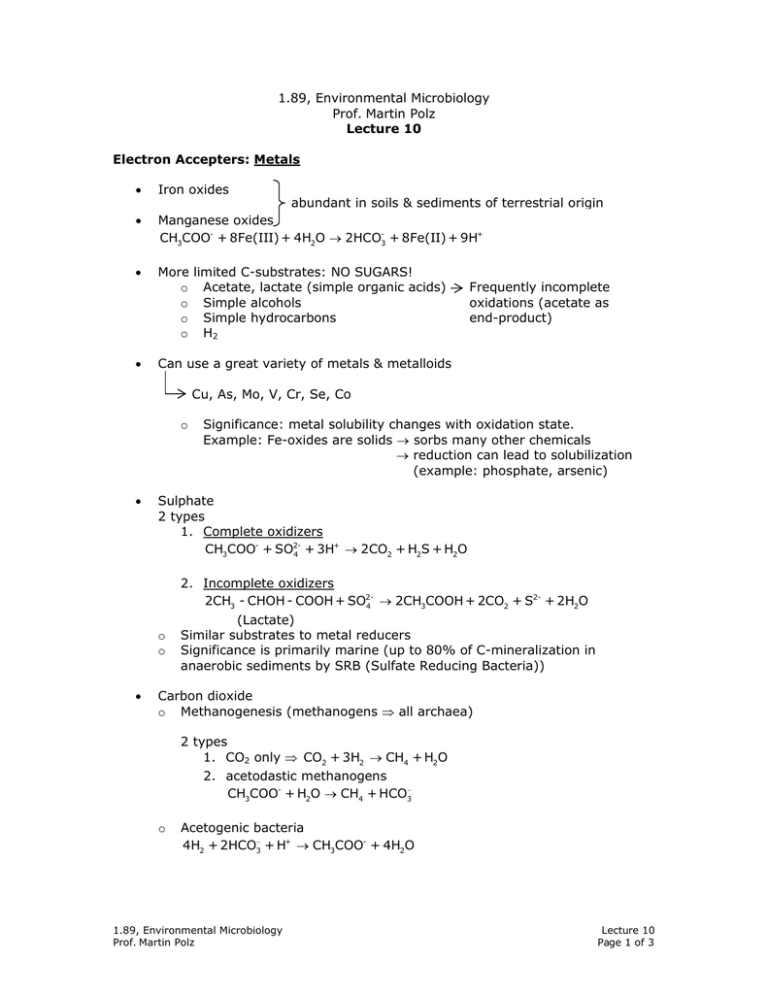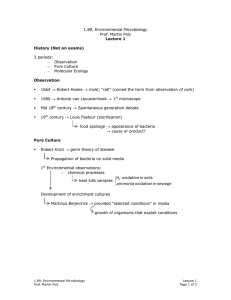1.89, Environmental Microbiology Prof. Martin Polz • Iron oxides
advertisement

1.89, Environmental Microbiology Prof. Martin Polz Lecture 10 Electron Accepters: Metals • • Iron oxides abundant in soils & sediments of terrestrial origin Manganese oxides CH3COO- + 8Fe(III) + 4H2O → 2HCO-3 + 8Fe(II) + 9H+ • More limited C-substrates: NO SUGARS! o Acetate, lactate (simple organic acids) o Simple alcohols o Simple hydrocarbons o H2 • Can use a great variety of metals & metalloids Frequently incomplete oxidations (acetate as end-product) Cu, As, Mo, V, Cr, Se, Co o Significance: metal solubility changes with oxidation state. Example: Fe-oxides are solids → sorbs many other chemicals → reduction can lead to solubilization (example: phosphate, arsenic) • Sulphate 2 types 1. Complete oxidizers + CH3COO- + SO24 + 3H → 2CO2 + H2S + H2O 2. Incomplete oxidizers 2CH3 - CHOH - COOH + SO2-4 → 2CH3COOH + 2CO2 + S2- + 2H2O (Lactate) o Similar substrates to metal reducers o Significance is primarily marine (up to 80% of C-mineralization in anaerobic sediments by SRB (Sulfate Reducing Bacteria)) • Carbon dioxide o Methanogenesis (methanogens ⇒ all archaea) 2 types 1. CO2 only ⇒ CO2 + 3H2 → CH4 + H2O 2. acetodastic methanogens CH3COO- + H2O → CH4 + HCO3− o Acetogenic bacteria 4H2 + 2HCO3− + H+ → CH3COO- + 4H2O 1.89, Environmental Microbiology Prof. Martin Polz Lecture 10 Page 1 of 3 Energetic considerations • Yield (Y): how much biomass/specific substrate can be made • Theoretically need 35 mmol ATP/g all biomass, so 1 mol ATP → 30 g cells. Experimental: o Streptococcus faecalis Yglucose = 22 g mol → 2 ATP / glu cos e o Zymomonas mobilis Yglucose = 8.3 g mol → 1 ATP / glu cos e ~ 10 g biomass/mol ATP Substrate consumption ] maintenance of life functions µ = growth rate Aerobes: 5C:1N → more into biomass, less into respiration Anaerobes: 5C:1N → more of this goes into respiration because lower yield of biomass unclear How is organic matter mineralized in aerobic vs. anaerobic environments? Paradox: most organic C = polymers (proteins, DNA, structural polysaccharides) • • Yet anaerobic respirers can only use very simple C-substrates Why is H2 usage so pervasive? Aerobic bacteria Specialized in respect to types of C-substrates used • Almost always mineralized to CO2 • Some have wide substrate spectrum (generalists) • Some have narrow substrate spectrum (specialists) Anaerobic bacteria • Cooperation for mineralization • Fermenters hydrolyze polymers & ferment monomers (example: sugars & amino acids) Excrete simple fatty acids substrates for Alcohols anaerobic respirers H2 Relationship between fermenter and anaerobic respirers = Syntrophy 1.89, Environmental Microbiology Prof. Martin Polz Lecture 10 Page 2 of 3 Reexamine fermentation Glucose + NAD NADH 2 pyruvate lactate CO2 acetaldehyde ethanol NAD+ But additional energy could be gained from reaction: ethanol ATP H2 + acetate } Problem is that this reaction has a positive �Go' Standard conditions ∆Go' = +19.4 KJ mol 2CH3CH2OH + 2H2O → 4H2 + 2CH3COOH + 2H+ ∆Greaction depends on H2 partial pressure anaerobic respirers have a high affinity for H2 ⇒ Close cooperation results in a crucial role of acetate & hydrogen in anaerobic environments ⇒ Anaerobic food chain 1.89, Environmental Microbiology Prof. Martin Polz Lecture 10 Page 3 of 3





